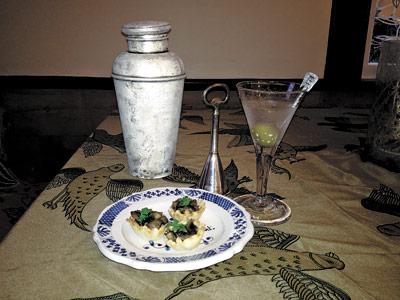Seasons by the Sea: The Truth About Vermouth

Rachel Maddow, the MSNBC host, is quite a mixologist. She occasionally pops up on “The Late Show With Jimmy Fallon” to demonstrate various cocktails. On a recent episode she demonstrated a classic martini. While shaking and stirring and measuring she informed Mr. Fallon that vermouth is a wine, therefore expires after two weeks. She encouraged the audience to toss out that old bottle of your granny’s that’s been collecting dust in the liquor cabinet and buy a fresh one. I obeyed. I sampled a fresh bottle. What a difference!
Until this revelation, vermouth was never on my radar. I didn’t even know what it is, it was just an ingredient . . . collecting dust in the liquor cabinet. A fortified wine, vermouth is a bit higher in alcohol than wine, and is aromatized with various botanicals. There is red vermouth and white vermouth. The red originated in Italy; the white in France around the 1880s. It was made from a neutral wine, fortified with brandy that had not been aged, and then flavored, and in the case of red, sweetened. The brands we are most familiar with are Noilly Prat and Martini, but there are now some domestic, boutique vermouth makers, most notably our very own Channing Daughters Winery in Bridgehampton, which has several variations.
After doing some in depth research, I learned that you really don’t have to throw an opened bottle of vermouth out after two weeks. It should last about three months if refrigerated, and will keep even better if you seal it with a Vacu-Vin cork. Cooking with vermouth is similar to cooking with wine, you just use a bit less and cook the alcohol out a fraction longer. It is delicious with scallops and sole, cream sauces, and poultry. I recently tossed a bit of dry vermouth into some sauteed mushrooms that then went into crisp little phyllo dough cups. It added just the right mysterious background note.
The name vermouth comes from the German word “vermut,” so called for its main ingredient, wormwood. As wormwood is toxic in large doses (this is the same ingredient that absinthe used to be made with), vermouth no longer contains it. In many European countries vermouth is enjoyed on its own as an aperitif, served with bread, cured meats, and cheese. Julia Child was known to enjoy a “reverse” martini: four parts vermouth to one part gin. Winston Churchill disdained vermouth, insisting that a glance at the open bottle was enough. Some stories go that he merely glanced in the direction of France, and that alone was enough vermouth for him.
Some of the current producers of vermouth add some crazy sounding ingredients. Bianca Miraglia, maker of Uncouth Vermouth out of Brooklyn, uses mugwort, a relative of wormwood, along with apples and mint. Imbue Bittersweet from Portland, Ore., apparently tastes like a honey Ricola candy. Atsby Amberthorn from Mattituck has a finish similar to sweetened liquid rye bread, according to Alice Fiering of The New York Times. Interesting. Channing Daughters spring 2013 Vervino vermouth is sauvignon blanc fortified with grape brandy, flavored with 30 botanicals, all “grown or foraged” locally, and sweetened with local honey.
Because of these unique flavorings, you want to use vermouth in recipes that can stand up to its funkiness. For savory dishes try dry vermouth with fennel and cream, penne with roasted beets, barbecued salmon with chives and tarragon, or mussels with shallots. Sweet vermouth can add a lot to fig jam, grilled peaches, and baked apples.
Of course, cocktails such as the Manhattan or a Negroni have to be made with sweet vermouth. And now that you know that freshness is key, start with a new bottle of French, domestic, or better yet, local vermouth and experiment with recipes and cocktails of your own.
Click for recipes
